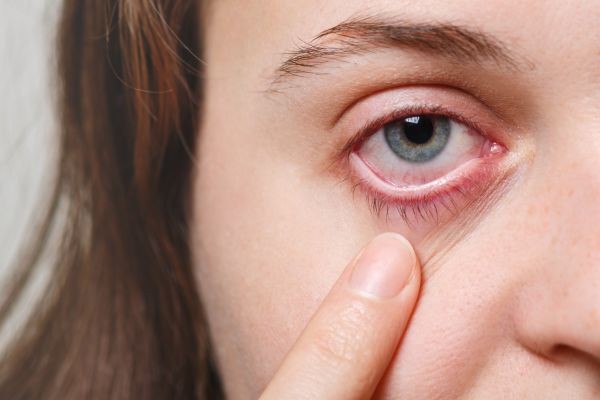Red eye is one of the most common eye complaints, and it can range from a mild irritation to a sign of a serious underlying condition. The redness occurs when blood vessels on the surface of the eye (conjunctiva) become dilated or inflamed, giving the eye a pink or bloodshot appearance. Understanding the causes of red eye can help you decide when simple home care is enough and when medical attention is necessary.
Common Causes of Red Eye
Red eye can result from several conditions affecting the eye’s surface, eyelids, or deeper structures. The most frequent causes include:
1. Conjunctivitis (Pink Eye)
Conjunctivitis is inflammation or infection of the conjunctiva, the thin membrane covering the white part of the eye.
-
Viral conjunctivitis is often caused by adenoviruses and spreads easily, especially during colds or respiratory infections.
-
Bacterial conjunctivitis leads to pus or discharge and may affect one or both eyes.
-
Allergic conjunctivitis is triggered by allergens like pollen, dust, or pet dander and is usually accompanied by itching and watery eyes.
Most forms are mild, but persistent or severe cases need professional evaluation.
2. Dry Eyes
When your eyes don’t produce enough tears or when tears evaporate too quickly, the surface becomes dry and irritated, causing redness, burning, and a gritty sensation. Common in people who spend long hours on digital screens, live in dry environments, or use contact lenses. Artificial tears, hydration, and screen breaks often help.
3. Blepharitis
This is inflammation of the eyelid margins, often due to bacterial overgrowth, oil gland dysfunction, or skin conditions like dandruff or rosacea. It causes redness, itching, and crusting of the eyelashes. Blepharitis is chronic but manageable with warm compresses, eyelid hygiene, and sometimes antibiotic ointments.
4. Subconjunctival Hemorrhage
Sometimes, a small blood vessel under the conjunctiva bursts, leading to a bright red patch on the white of the eye. This looks alarming but is usually harmless and painless. It may occur after coughing, sneezing, heavy lifting, or spontaneously. It clears up within one to two weeks without treatment.
5. Corneal Irritation or Injury
The cornea, the clear front layer of the eye, is sensitive. Dust, sand, chemical splashes, or contact lens overuse can cause irritation, leading to redness, tearing, and pain. Corneal abrasions or infections (keratitis) require prompt medical care to prevent vision loss.
6. Uveitis
Uveitis is inflammation of the uvea, the middle layer of the eye, and may result from autoimmune diseases (like rheumatoid arthritis), infections, or trauma. Symptoms include deep eye pain, redness, blurred vision, and sensitivity to light. Uveitis is serious and needs urgent ophthalmic evaluation to avoid complications such as glaucoma or vision impairment.
7. Glaucoma (Acute Angle-Closure Type)
A sudden, painful red eye with blurred vision, halos around lights, and nausea may signal acute angle-closure glaucoma—a medical emergency. It occurs when fluid drainage from the eye is suddenly blocked, raising intraocular pressure dramatically. Immediate treatment is essential to prevent permanent vision loss.
8. Contact Lens-Related Problems
Improper contact lens hygiene, overwearing lenses, or sleeping in them can lead to irritation, infection, or corneal ulcers. Redness accompanied by pain, discharge, or blurred vision should never be ignored. Always follow your optometrist’s lens care instructions.
When to See a Doctor
While mild redness often resolves with rest and lubrication, seek medical help immediately if you experience:
-
Severe eye pain or sensitivity to light
-
Sudden changes in vision or blurriness
-
Discharge or crusting
-
Redness after eye injury or chemical exposure
-
Persistent redness lasting more than a few days
Early diagnosis can prevent serious complications and protect your vision.
Tips to Prevent Red Eye
-
Practice good hygiene: Wash hands before touching your eyes or contact lenses.
-
Avoid rubbing your eyes: It worsens irritation and spreads infection.
-
Limit screen time: Follow the “20-20-20 rule” — every 20 minutes, look 20 feet away for 20 seconds.
-
Stay hydrated and use humidifiers in dry environments.
-
Wear protective eyewear during sports or dusty activities.
-
Replace eye makeup regularly and avoid sharing cosmetics.
Conclusion
Red eye can result from something as simple as dryness or as serious as glaucoma. Paying attention to accompanying symptoms — such as pain, discharge, or vision changes — helps differentiate minor irritation from emergencies. If in doubt, consult an ophthalmologist or optometrist for a comprehensive eye examination. Early treatment not only relieves discomfort but also safeguards your long-term vision and eye health.

